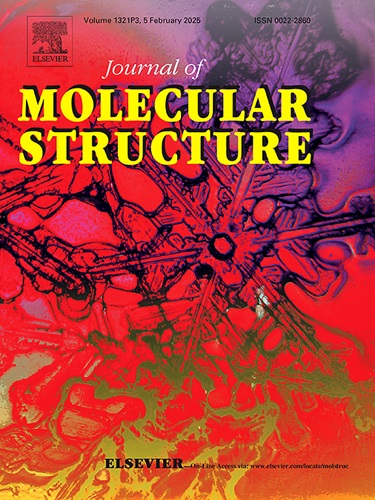1.5 mol % Zn取代对LiNbO3单晶宽带太赫兹光学参数的影响
IF 4
2区 化学
Q2 CHEMISTRY, PHYSICAL
引用次数: 0
摘要
铌酸锂(LiNbO3,LN)晶体被认为是一种重要的光学功能材料,在太赫兹(THz)光子学领域受到广泛关注。这种兴趣主要体现在通过差频产生(DFG)或光学整流(OR)以及电子光学(EO)检测来产生和检测太赫兹波。此外,这些晶体对于用于太赫兹光束转向的光学元件也至关重要。本研究全面考察了共价铌酸锂 (SLN) 和 1.5 mol % Zn 掺杂共价铌酸锂 (Zn:SLN) z 型单晶的太赫兹光学特性。利用 PXRD 测量分析了相纯度和晶格结构,并利用拉曼光谱研究了现有的晶格振动模式。此外,在 0.4 至 1.6 太赫兹的频率范围内,采用透射模式的太赫兹时域光谱(THz-TDS)对两种晶体的折射率、吸收系数和介电函数进行了详细表征。实验结果表明,掺杂 1.5 摩尔% 的锌可大幅提高太赫兹光学参数。值得注意的是,实验结果与洛伦兹阻尼谐振子(DHO)理论模型十分吻合,这证实了未掺杂和掺杂锌的 SLN 晶体的介电响应受最低横向光学 E(TO1) 振动模式的支配。此外,锌掺杂会明显改变未掺杂 SLN 单晶的拟合参数。这项研究为通过掺杂 1.5 摩尔% 的 Zn 来调整 LiNbO3 的太赫兹响应提供了宝贵的信息,为其在下一代太赫兹光子学以及太赫兹辐射发射器和探测器等应用中的优化使用铺平了道路。本文章由计算机程序翻译,如有差异,请以英文原文为准。
The effect of 1.5 mol % Zn substitution on the broadband THz optical parameters of stoichiometric LiNbO3 single crystal
Lithium Niobate (LiNbO3, LN) crystals, recognized as a significant optical functional material, have gained extensive interest in terahertz (THz) photonics. This particular interest is prominently evident in the generation and detection of THz waves through difference frequency generation (DFG) or optical rectification (OR), as well as electro-optical (EO) detection. Moreover, these crystals are essential to the optical components employed for THz beam steering. The present work comprehensively investigates the THz optical properties of stoichiometric lithium niobate (SLN) and 1.5 mol % Zn-doped stoichiometric lithium niobate (Zn:SLN) z-oriented single crystals, which are grown from Li-rich melt using high temperature top seeded solution growth method. The phase purity and lattice structure were analyzed using PXRD measurements, while Raman spectroscopy was employed to investigate the existing lattice vibrational modes. Furthermore, the detailed characterization of the refractive index, absorption coefficient, and dielectric function of both crystals is performed by employing the terahertz time-domain spectroscopy (THz-TDS) in transmission mode within the frequency range of 0.4 to 1.6 THz. The experiment revealed that 1.5 mol % Zn doping resulted in a substantial enhancement of the THz optical parameters. Remarkably, the experimentally obtained results are aligned well with the theoretical Lorentz damped harmonic oscillator (DHO) model, which confirms that the dielectric response of undoped and Zn-doped SLN crystals is governed by the lowest transverse optical E(TO1) mode of vibration. Also, Zn-doping significantly alters the fitting parameters of the undoped SLN single crystal. This investigation provides invaluable information on tuning the THz response of LiNbO3 through 1.5 mol % Zn doping, paving the way for its optimized use in next-generation THz photonics and applications such as THz radiation emitter and detector.
求助全文
通过发布文献求助,成功后即可免费获取论文全文。
去求助
来源期刊

Journal of Molecular Structure
化学-物理化学
CiteScore
7.10
自引率
15.80%
发文量
2384
审稿时长
45 days
期刊介绍:
The Journal of Molecular Structure is dedicated to the publication of full-length articles and review papers, providing important new structural information on all types of chemical species including:
• Stable and unstable molecules in all types of environments (vapour, molecular beam, liquid, solution, liquid crystal, solid state, matrix-isolated, surface-absorbed etc.)
• Chemical intermediates
• Molecules in excited states
• Biological molecules
• Polymers.
The methods used may include any combination of spectroscopic and non-spectroscopic techniques, for example:
• Infrared spectroscopy (mid, far, near)
• Raman spectroscopy and non-linear Raman methods (CARS, etc.)
• Electronic absorption spectroscopy
• Optical rotatory dispersion and circular dichroism
• Fluorescence and phosphorescence techniques
• Electron spectroscopies (PES, XPS), EXAFS, etc.
• Microwave spectroscopy
• Electron diffraction
• NMR and ESR spectroscopies
• Mössbauer spectroscopy
• X-ray crystallography
• Charge Density Analyses
• Computational Studies (supplementing experimental methods)
We encourage publications combining theoretical and experimental approaches. The structural insights gained by the studies should be correlated with the properties, activity and/ or reactivity of the molecule under investigation and the relevance of this molecule and its implications should be discussed.
 求助内容:
求助内容: 应助结果提醒方式:
应助结果提醒方式:


